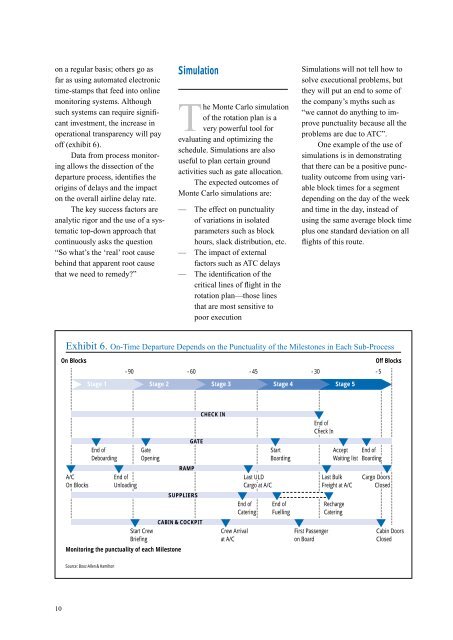Punctuality: How Airlines Can Improve On-Time Performance
Punctuality: How Airlines Can Improve On-Time Performance
Punctuality: How Airlines Can Improve On-Time Performance
Create successful ePaper yourself
Turn your PDF publications into a flip-book with our unique Google optimized e-Paper software.
on a regular basis; others go as<br />
far as using automated electronic<br />
time-stamps that feed into online<br />
monitoring systems. Although<br />
such systems can require significant<br />
investment, the increase in<br />
operational transparency will pay<br />
off (exhibit 6).<br />
Data from process monitoring<br />
allows the dissection of the<br />
departure process, identifies the<br />
origins of delays and the impact<br />
on the overall airline delay rate.<br />
The key success factors are<br />
analytic rigor and the use of a systematic<br />
top-down approach that<br />
continuously asks the question<br />
“So what’s the ‘real’ root cause<br />
behind that apparent root cause<br />
that we need to remedy?”<br />
10<br />
Simulation<br />
The Monte Carlo simulation<br />
of the rotation plan is a<br />
very powerful tool for<br />
evaluating and optimizing the<br />
schedule. Simulations are also<br />
useful to plan certain ground<br />
activities such as gate allocation.<br />
The expected outcomes of<br />
Monte Carlo simulations are:<br />
— The effect on punctuality<br />
of variations in isolated<br />
parameters such as block<br />
hours, slack distribution, etc.<br />
— The impact of external<br />
factors such as ATC delays<br />
— The identification of the<br />
critical lines of flight in the<br />
rotation plan—those lines<br />
that are most sensitive to<br />
poor execution<br />
Simulations will not tell how to<br />
solve executional problems, but<br />
they will put an end to some of<br />
the company’s myths such as<br />
“we cannot do anything to improve<br />
punctuality because all the<br />
problems are due to ATC”.<br />
<strong>On</strong>e example of the use of<br />
simulations is in demonstrating<br />
that there can be a positive punctuality<br />
outcome from using variable<br />
block times for a segment<br />
depending on the day of the week<br />
and time in the day, instead of<br />
using the same average block time<br />
plus one standard deviation on all<br />
flights of this route.<br />
Exhibit 6. <strong>On</strong>-<strong>Time</strong> Departure Depends on the <strong>Punctuality</strong> of the Milestones in Each Sub-Process<br />
<strong>On</strong> Blocks Off Blocks<br />
A/C<br />
<strong>On</strong> Blocks<br />
Stage 1 Stage 2 Stage 3 Stage 4 Stage 5<br />
End of<br />
Deboarding<br />
Source: Booz·Allen & Hamilton<br />
End of<br />
Unloading<br />
Gate<br />
Opening<br />
Start Crew<br />
Briefing<br />
RAMP<br />
GATE<br />
SUPPLIERS<br />
CABIN & COCKPIT<br />
Monitoring the punctuality of each Milestone<br />
-90 -60 -45 -30 -5<br />
CHECK IN<br />
Last ULD<br />
Cargo at A/C<br />
End of<br />
Catering<br />
Crew Arrival<br />
at A/C<br />
Start<br />
Boarding<br />
End of<br />
Fuelling<br />
End of<br />
Check In<br />
First Passenger<br />
on Board<br />
Accept<br />
Waiting list<br />
Last Bulk<br />
Freight at A/C<br />
Recharge<br />
Catering<br />
End of<br />
Boarding<br />
Cargo Doors<br />
Closed<br />
Cabin Doors<br />
Closed




